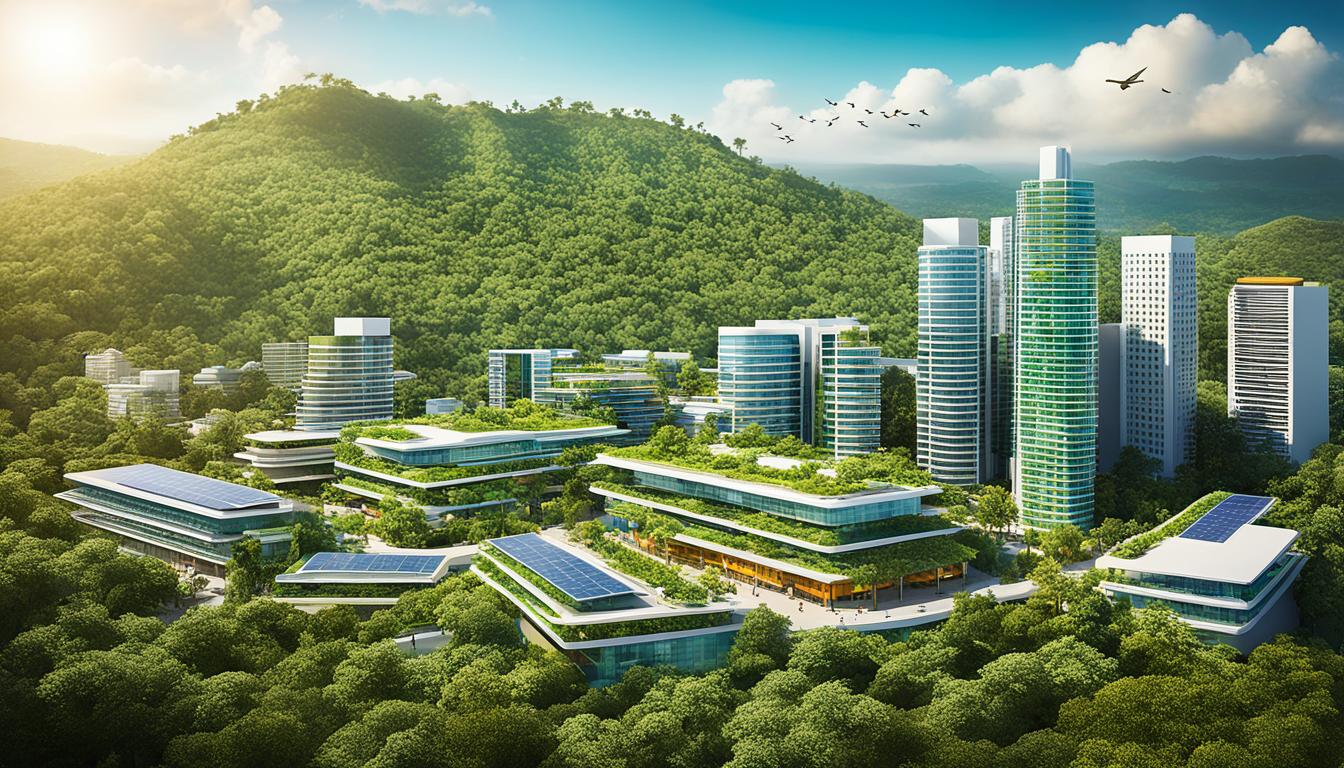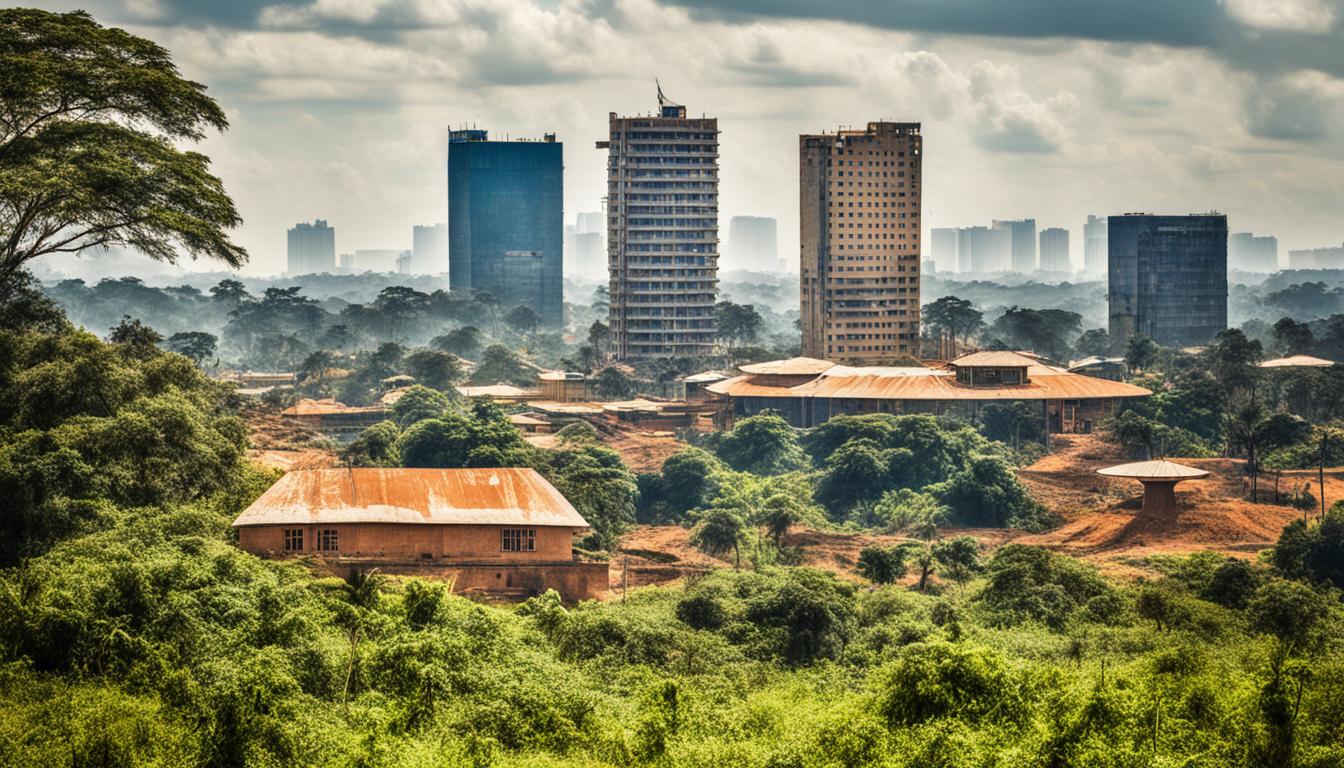Ivory Coast (Côte d’Ivoire) Biodiversity and the Built Environment
Did you know that Ivory Coast, also known as Côte d’Ivoire, is a country in West Africa that boasts rich biodiversity and is committed to sustainable development?
With its diverse wildlife, ecosystems, and urban landscapes, Ivory Coast is actively working to strike a balance between preserving its precious biodiversity and promoting sustainable practices in the built environment.
Key Takeaways:
- Ivory Coast is striving to protect its biodiversity while promoting sustainable development in its built environment
- The country has experienced significant biodiversity loss due to deforestation caused by agriculture and timber production
- Invasive alien species, pollution, and habitat destruction pose threats to Ivory Coast’s wildlife and ecosystems
- Conservation efforts, sustainable agriculture, and research institutions are working towards preserving Ivory Coast’s flora and fauna
- Ivory Coast is making strides in sustainable architecture and energy-efficient construction practices
Biodiversity Loss and Deforestation in Ivory Coast
Ivory Coast, located in West Africa, has faced significant challenges in terms of biodiversity loss and deforestation over the years. The country’s rich natural heritage, including diverse ecosystems and species, has been under threat due to various factors.
One major contributor to deforestation in Ivory Coast is timber production. The demand for timber, both locally and internationally, has led to widespread logging activities, resulting in the depletion of forest resources. Additionally, agriculture plays a significant role in deforestation, particularly through the cultivation of export crops like coffee, cocoa, rubber, pineapple, and oil palm. These cash crops often require extensive land clearing, leading to the loss of valuable forest cover.
Traditional agricultural practices, such as the use of slash-and-burn techniques, have further exacerbated the issue. While these practices may have been sustainable in the past, the increasing population and demand for agricultural products have intensified their negative impact on the environment.
| Contributing Factors | Effects |
|---|---|
| Timber production | – Loss of forest cover – Disruption of ecosystems – Threat to wildlife habitats |
| Agriculture | – Land clearing for cash crop cultivation – Habitat destruction – Soil erosion |
| Traditional agricultural practices | – Increased deforestation – Soil degradation – Air pollution from burning |
It is crucial to address the issue of biodiversity loss and deforestation in Ivory Coast to maintain the ecological balance and preserve the country’s unique natural heritage. Efforts are being made to promote sustainable land use practices, preserve remaining forest areas, and engage local communities in conservation initiatives.
“The loss of biodiversity and deforestation in Ivory Coast not only impacts the environment but also poses challenges for the country’s economy and the well-being of its people. It is essential to strike a balance between sustainable development and the preservation of invaluable natural resources.”
Effects of Biodiversity Loss and Deforestation
The consequences of biodiversity loss and deforestation in Ivory Coast are far-reaching. Some of the key effects include:
- Loss of habitat for wildlife, leading to a decline in species population
- Disruption of ecosystems, impacting the natural balance and functioning of the environment
- Reduced availability of natural resources, affecting local communities’ livelihoods
- Increased vulnerability to climate change impacts, such as soil erosion and flooding
Addressing these issues requires a comprehensive approach that combines sustainable land-use practices, conservation efforts, and community engagement. By promoting responsible agricultural practices, protecting remaining forest areas, and raising awareness about the importance of biodiversity, Ivory Coast can work towards a more sustainable future.
Threats to Biodiversity in Ivory Coast
Ivory Coast, also known as Côte d’Ivoire, is home to diverse wildlife and ecosystems. However, the country faces various threats that endanger its rich biodiversity. These threats include the presence of invasive alien species, pollution, and habitat destruction caused by agriculture, urban development, and the oil and gas industry.
Invasive Alien Species
Invasive alien species pose a significant risk to Ivory Coast’s biodiversity. Species like water hyacinth, water fern, and water lettuce have invaded the country’s rivers, lakes, and lagoons, disrupting the native ecosystems. These invasive species outcompete native plants, depriving them of vital resources and altering the natural balance of the aquatic habitats.
Pollution
Pollution is another major threat to Ivory Coast’s biodiversity. Industrial activities, including agriculture and the oil and gas industry, release pollutants into the environment, contaminating water bodies, soil, and air. Chemical pesticides and fertilizers used in agriculture can leach into water sources, harming aquatic life. Pollution leads to habitat degradation and can have harmful effects on wildlife populations.
Habitat Destruction
Agricultural expansion, urban development, and the extraction of natural resources are significant drivers of habitat destruction in Ivory Coast. Forests are cleared for agriculture, particularly for export crops like cocoa and oil palm. These activities result in the loss of crucial habitats for many plant and animal species. As habitats shrink, populations decline, and some species may face the risk of extinction.
Efforts must be made to address these threats and protect Ivory Coast’s unique biodiversity. Conservation initiatives, sustainable practices, and increased awareness are essential for ensuring a harmonious coexistence between development and the preservation of wildlife and ecosystems.

| Threats | Description |
|---|---|
| Invasive Alien Species | Water hyacinth, water fern, and water lettuce invading rivers, lakes, and lagoons, disrupting native ecosystems. |
| Pollution | Industrial activities releasing pollutants, contaminating water bodies, soil, and air. |
| Habitat Destruction | Deforestation for agriculture, urban development, and resource extraction, leading to habitat loss. |
Conservation Efforts in Ivory Coast
Ivory Coast is committed to preserving its rich biodiversity through various conservation efforts. The country has established protected areas spanning 17% of its national territory, safeguarding critical ecosystems and wildlife habitats. These protected areas are managed at different levels, including local involvement in forest management. By engaging non-state actors, Ivory Coast aims to ensure the long-term protection and sustainable use of its natural resources.
Furthermore, Ivory Coast recognizes the importance of sustainable agriculture in biodiversity conservation. The country is investing in innovative farming practices that minimize environmental impact, such as organic farming, agroforestry, and the use of integrated pest management techniques. These sustainable agricultural methods promote the preservation of biodiversity while supporting local food production and economic growth.
Research institutions in Ivory Coast play a vital role in advancing conservation efforts. These institutions are dedicated to studying the country’s unique flora and fauna, identifying key conservation priorities, and developing strategies to mitigate the threats faced by endangered species. Through scientific research and collaboration, Ivory Coast can make informed decisions and implement effective conservation measures to protect its natural heritage.
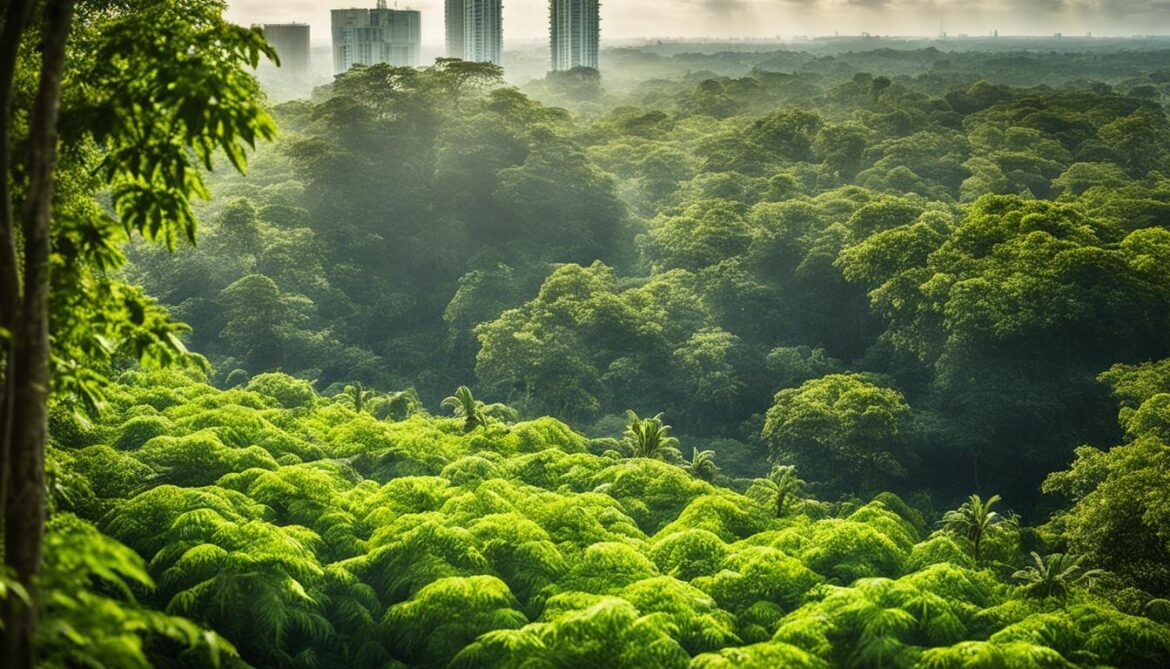
“The conservation of biodiversity is crucial for the well-being of present and future generations. Ivory Coast’s efforts in establishing protected areas, promoting sustainable agriculture, and supporting research institutions demonstrate its commitment to preserving its natural heritage.”
Protected Areas in Ivory Coast
| Name | Location | Size |
|---|---|---|
| Taï National Park | Western region | 3,300 square kilometers |
| Comoe National Park | North region | 11,500 square kilometers |
| Marahoue National Park | Central region | 1,025 square kilometers |
Research Institutions
- Institute of Tropical Ecology
- Centre Suisse de Recherches Scientifiques en Côte d’Ivoire (CSRS)
- Centre d’Etude de la Biodiversité Africaine (CEBA)
Green Buildings in Ivory Coast
Ivory Coast is taking significant steps towards sustainable architecture and energy-efficient construction practices, contributing to the country’s efforts to achieve a balance between urban development and environmental sustainability. One notable example is the Bamboo Pavilion, which exemplifies the innovative use of renewable materials and design.
The Bamboo Pavilion is a remarkable showcase of Ivory Coast’s commitment to sustainable architecture. It incorporates bamboo, a rapidly renewable resource, in its construction, promoting environmentally friendly building practices. The pavilion’s design also emphasizes energy efficiency, utilizing passive solar techniques, natural ventilation, and efficient insulation to reduce the ecological footprint.

This captivating structure stands as a testament to Ivory Coast’s dedication to sustainable development and showcases how green buildings can harmoniously integrate with the natural environment. Constructed using locally sourced materials, the Bamboo Pavilion demonstrates the country’s promotion of sustainable practices and highlights the potential for a greener and more sustainable future.
Sustainable Architecture and Energy Efficiency
Ivory Coast’s focus on sustainable architecture extends beyond the Bamboo Pavilion. The country is embracing energy-efficient construction techniques that prioritize reducing energy consumption and minimizing environmental impact. These practices include designing buildings with optimal insulation, energy-efficient lighting systems, and sophisticated solar technologies to harness clean and renewable energy sources.
Furthermore, green buildings in Ivory Coast incorporate sustainable and locally sourced materials, such as bamboo, which has a low environmental impact compared to traditional building materials. Bamboo is not only durable and versatile but also regrows quickly, making it an ideal choice for sustainable construction.
| Benefits of Green Buildings in Ivory Coast | Examples of Green Buildings in Ivory Coast |
|---|---|
|
|
The adoption of sustainable architecture and green building practices in Ivory Coast not only benefits the environment but also contributes to improved quality of life for its residents. By prioritizing energy efficiency, the country is working towards a more sustainable future while setting an example for other nations.
“The Bamboo Pavilion in Ivory Coast showcases the beauty and potential of sustainable architecture, highlighting the country’s commitment to green building practices and environmental conservation.” – Architectural Digest
In this section, we explore how Ivory Coast is embracing sustainable architecture and energy-efficient construction practices. With the iconic Bamboo Pavilion leading the way, the country demonstrates its dedication to environmental sustainability and the integration of green buildings in its urban development. Through the use of renewable materials and innovative design, Ivory Coast is paving the way for a greener and more sustainable future.
Government Initiatives for Sustainable Development
The government of Ivory Coast is committed to driving sustainable development through a range of initiatives and policies. The nation’s efforts align with the global goals for a greener and more resilient future. Ivory Coast’s dedication to sustainability is demonstrated by its focus on achieving the Nationally Determined Contributions (NDCs), which tackle key issues such as energy, waste, infrastructure, and transportation, with the aim of reducing emissions by 28% by 2030.
One notable achievement in Ivory Coast’s sustainable development journey is the issuance of its first corporate green bond. The Cosmos Yopougon shopping center successfully launched this initiative, reflecting the country’s potential for private-sector climate finance. This innovative financial instrument paves the way for future investments in environmentally friendly projects, further accelerating sustainable development in Ivory Coast.
The government’s commitment to sustainable development is driving meaningful change and opening opportunities for collaboration with both public and private entities. Together, these initiatives contribute to the country’s progress towards a more sustainable and resilient future.
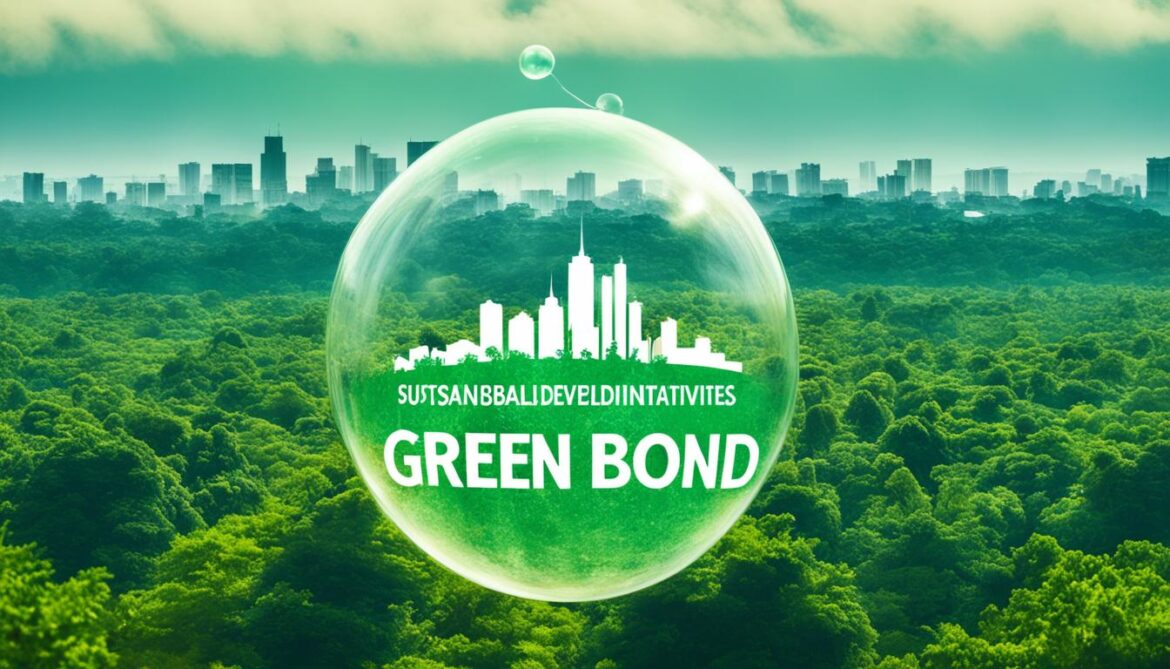
Key Government Initiatives for Sustainable Development
- Nationally Determined Contributions (NDCs) – Addressing energy, waste, infrastructure, and transportation to reduce emissions by 28% by 2030.
- Corporate Green Bond by Cosmos Yopougon shopping center – Showcasing the potential for private-sector climate finance in Ivory Coast.
Challenges and Future Plans for Biodiversity Conservation
Biodiversity conservation in Ivory Coast has made significant progress, but the nation still faces challenges that need to be addressed in order to ensure a sustainable future. These challenges include:
- Lack of Information: A major obstacle in biodiversity conservation efforts is the lack of comprehensive and up-to-date information about the country’s diverse ecosystems and species. Without accurate data, it becomes difficult to formulate effective conservation strategies.
- Resistance to Change: Encouraging sustainable practices and promoting biodiversity conservation often encounters resistance from various stakeholders. Overcoming this resistance and fostering a mindset shift towards sustainable development remains a significant challenge.
- Traceability Systems: Implementing traceability systems for agricultural products is crucial to tackle deforestation caused by unsustainable farming practices. Ensuring transparency and accountability throughout the supply chain can help prevent further degradation of the environment.
- Coordination of Actions: Coordinating actions among different stakeholders, including government agencies, conservation organizations, local communities, and businesses, is essential for effective biodiversity conservation. Improved collaboration and partnerships can lead to more impactful outcomes.
Despite these challenges, Ivory Coast has ambitious future plans for biodiversity conservation. One of the primary goals is to restore 20% of its forest cover by 2030 through reforestation efforts. Additionally, the promotion of agroforestry and sustainable agriculture practices plays a crucial role in the country’s conservation plans. These practices aim to strike a balance between agricultural productivity and the preservation of natural ecosystems.
The commitment to overcoming challenges and implementing future plans demonstrates Ivory Coast’s dedication to biodiversity conservation and sustainable development.
| Challenges | Solutions |
|---|---|
| Lack of Information | Investing in comprehensive research and data collection to fill knowledge gaps. |
| Resistance to Change | Increasing awareness, education, and engagement to foster a culture of sustainability. |
| Traceability Systems | Implementing robust tracking systems to ensure the sustainable sourcing of agricultural products. |
| Coordination of Actions | Facilitating collaboration among stakeholders through partnerships and effective communication channels. |

The image above showcases the diverse and vibrant wildlife that Ivory Coast aims to protect through its biodiversity conservation efforts.
The Role of the Cocoa and Forests Initiative
The Cocoa and Forests Initiative plays a crucial role in addressing deforestation in the cocoa supply chain in Ivory Coast. This initiative aims to eliminate deforestation and restore forest areas by promoting sustainable cocoa farming practices.
Ivory Coast, along with other top cocoa-producing countries, is committed to ending deforestation in the cocoa industry and implementing sustainable cocoa farming strategies.
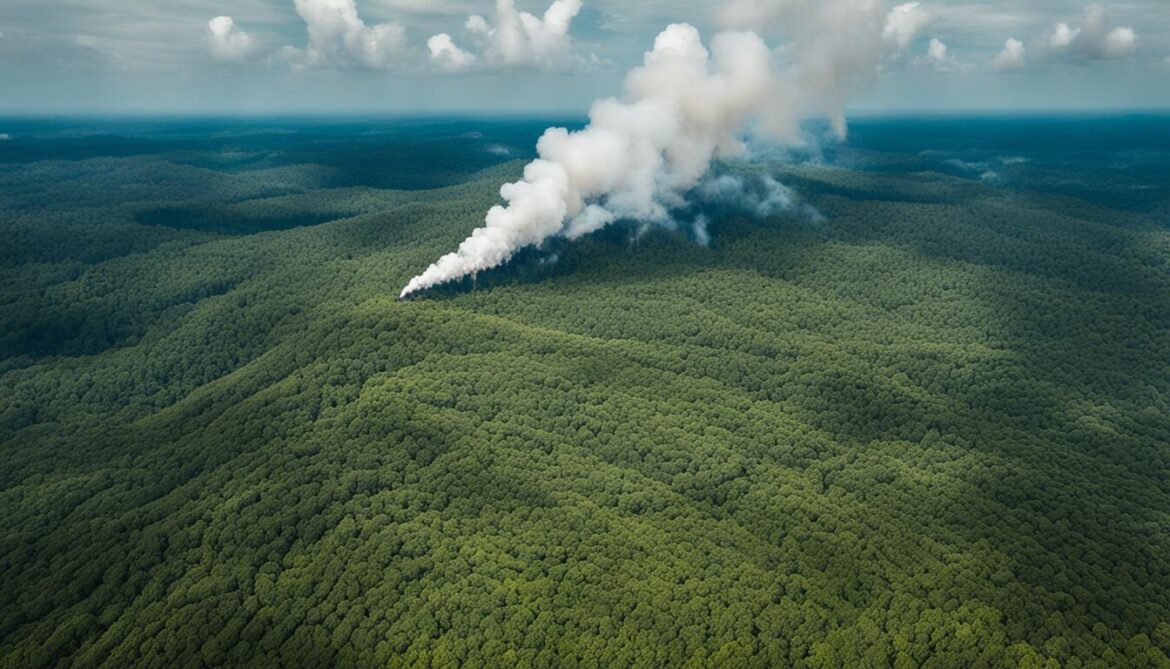
Progress of the Cocoa and Forests Initiative
“The Cocoa and Forests Initiative has made significant progress in combatting deforestation in Ivory Coast and promoting sustainable cocoa farming practices.” – Cocoa Farmer
Since its inception, the Cocoa and Forests Initiative has achieved notable milestones towards its goals. Through collaboration between the government, cocoa companies, and civil society, the initiative has implemented various measures to protect forests and promote sustainable practices in cocoa farming.
Sustainable Cocoa Farming Practices
The Cocoa and Forests Initiative encourages the adoption of sustainable cocoa farming practices in Ivory Coast. These practices include:
- Implementing agroforestry techniques that incorporate shade trees and diverse crops.
- Promoting environmentally friendly pest and disease management.
- Encouraging the use of organic fertilizers to reduce chemical inputs.
Protecting Forest Areas
One of the primary objectives of the Cocoa and Forests Initiative is to protect and restore forest areas in Ivory Coast. To achieve this, stakeholders are committed to:
- Mapping and monitoring forest areas to identify deforestation hotspots.
- Developing land-use plans that prioritize forest conservation.
- Implementing measures to prevent encroachment and illegal logging.
Building Partnerships
The success of the Cocoa and Forests Initiative relies on strong partnerships between governments, cocoa companies, farmers, and civil society organizations. These partnerships facilitate the exchange of knowledge, resources, and best practices to drive sustainable change throughout the cocoa value chain.
By working together, these stakeholders can protect the environment, improve livelihoods for cocoa farmers, and ensure the long-term sustainability of the cocoa industry in Ivory Coast.
The Impact of the Cocoa and Forests Initiative
Since the implementation of the Cocoa and Forests Initiative, there have been positive outcomes in biodiversity conservation, forest restoration, and sustainable cocoa production in Ivory Coast.
| Impact Areas | Progress |
|---|---|
| Biodiversity Conservation | Protected forest areas increased by 2 million hectares. |
| Forest Restoration | Over 220,000 hectares of deforested areas have been restored. |
| Sustainable Cocoa Production | Increased adoption of sustainable farming practices by cocoa farmers. |
The Importance of Private-Sector Climate Finance
Private-sector climate finance plays a crucial role in supporting sustainable development in Ivory Coast. By investing in climate-friendly initiatives, private companies contribute to the country’s efforts to address environmental challenges and promote a greener future.
One notable example of private-sector climate finance in Ivory Coast is the issuance of corporate green bonds. The Cosmos Yopougon shopping center, for instance, has successfully issued a corporate green bond to fund climate-friendly projects. This demonstrates the potential for private-sector investment in sustainable initiatives and highlights the commitment of businesses to environmental responsibility.
Corporate green bonds provide a means for companies to raise funds specifically for environmentally friendly infrastructure and sustainable practices. These bonds are tailored to attract investors interested in supporting projects that align with their sustainability goals. By issuing green bonds, companies in Ivory Coast not only raise capital but also contribute to the country’s overall sustainable development agenda.
“Private-sector climate finance is a powerful tool for promoting sustainable practices and achieving environmental goals. By mobilizing private capital for climate-friendly initiatives, we can drive positive change and create a more sustainable future for Ivory Coast.”
Private-sector climate finance has the potential to drive innovation and accelerate the transition to a low-carbon economy. By encouraging private investment in renewable energy, energy-efficient technologies, and sustainable agriculture, Ivory Coast can achieve its climate targets and promote economic growth.
In conclusion, private-sector climate finance is a crucial component of Ivory Coast’s sustainable development strategy. The issuance of corporate green bonds exemplifies the potential for private companies to contribute to climate-friendly initiatives. Through these investments, Ivory Coast can continue its progress towards a more sustainable future.

Benefits of Private-Sector Climate Finance in Ivory Coast:
- Provides funding for climate-friendly projects and sustainable practices
- Encourages private investment in renewable energy and energy-efficient technologies
- Supports the country’s transition to a low-carbon economy
- Contributes to Ivory Coast’s overall sustainable development agenda
- Drives innovation and fosters economic growth
Conclusion
Ivory Coast, also known as Côte d’Ivoire, is making significant strides in finding a balance between biodiversity conservation and urban development for sustainable futures. Through the implementation of various initiatives, regulations, and conservation efforts, the country is actively working towards protecting its rich biodiversity and promoting sustainable practices in the built environment.
Despite the challenges that Ivory Coast faces, including deforestation and habitat destruction, the commitment to sustainable development and conservation efforts serves as an inspiration for other countries striving for a greener and more sustainable future. The establishment of protected areas, investment in sustainable agriculture practices, and the promotion of energy-efficient construction techniques, such as the Bamboo Pavilion, are all contributing to the country’s efforts in achieving this balance.
With ambitious plans for reforestation and the commitment to eliminating deforestation in the cocoa supply chain through initiatives like the Cocoa and Forests Initiative, Ivory Coast is demonstrating its dedication to protecting its natural resources while promoting economic growth. The country’s commitment to sustainable development and conservation is paving the way for a more environmentally friendly and prosperous future.




